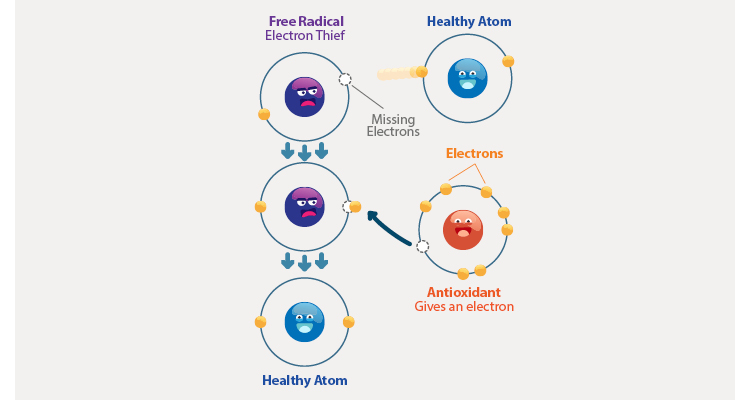You may have heard the term antioxidants and foods that promote high levels of antioxidants, but what does it all mean?
What are free radicals?
Let's start by discussing free radicals and how they occur in the body. Free radicals are atoms, ions or molecules in the body that have an unpaired electron. This makes them highly unstable and reactive to whatever comes in their path. This reaction is known as oxidation, you might have seen this reaction when you cut open an apple and it goes brown. Free radicals cause unwanted chemical reactions within the cell membrane (the outer protective layer of the cell). Oxidation causes damage to cells and DNA, which can lead to many negative health conditions.
How are free radicals created?
The body experiences free radicals and oxidation as a result of both internal and external sources. External sources include air and water pollution, alcohol, smoking, chemicals in the environment like pesticides, stress, a diet lacking in nutrients, exercise, and inflammation. On the other hand, internal sources are created by normal cell metabolism in the body, and this oxidation is a necessary process. When the body contains high levels of free radicals, it is known as oxidative stress. Research suggests that oxidative stress levels are raised in conditions such as chronic fatigue syndrome, Alzheimer's disease, sub-fertility (delays in conceiving), depression, and hypertension (high blood pressure), among others.
How do antioxidants work?
Antioxidants, also known as free radical scavengers, work by donating an electron to free radicals. This extra electron neutralizes the free radical, making it stable. The key is having enough antioxidants in the body to neutralize all the free radicals. As shown in the diagram it is visible as to how the antioxidant can freely donate an electron, resulting in the free radical becoming balanced and neutralised. When the number of free radicals is more than the number of antioxidants oxidative stress can start to occur.

Where to get antioxidants and when do you need extra support.
Eating a variety of foods is crucial to ensure that we get enough antioxidants in our diet. One popular way to achieve this is by following the phrase "eat the rainbow" with fruits and vegetables. Consuming a diverse range of colourful fruits and vegetables can provide us with a variety of antioxidants that are essential for our health. Although it is best to source antioxidants from food, sometimes our bodies need an extra boost, and that's where supplements can help us fill the gap. Our bodies may require additional antioxidant support during long periods of stress, surgery or injury recovery, athletes or those with high-intensity exercise regimes, or when treating long-term illnesses. While there are many vitamins and antioxidant supplements available in the market that can be beneficial, greater benefits are observed when antioxidants can work in combination with other nutrients, plant chemicals, and even other antioxidants. For instance, strawberries are an excellent source of vitamin C, which has high antioxidant activity. One cup of strawberries provides approximately 80mg of vitamin C. However, when compared to a supplement containing 500mg of vitamin C, the supplement does not contain plant sourced chemicals such as polyphenols and flavonoids, which have extra antioxidant actions.
What to look for when choosing antioxidant supplements:
• Plant sourced ingredients (providing a wider range of antioxidants, rather than an isolated antioxidant)
• Free from solvents, pesticides and heavy metals
• Water-only extraction
• GMO free In the Health House
CAA-Multi, you may notice the antioxidants and bioflavonoids, these are in the form of citrus bioflavonoids. CAA-Multi offers great benefits combined with all of the vitamins and minerals. You can gain even greater benefits by taking specific antioxidant supplements in combination with the CAA-Multi, especially those from a wider range of fruits.